The Redirect pop-ups appeared on your computer without any notice? After that, you’re faced with the fact that your web browser is now re-directed to other intrusive web sites and filled with a variety of ads and banners. The cause of all your problems with your personal computer is ‘ad-supported’ software (also known as adware) that has been installed on many systems around the world without users permission, so you’re one of many. Most probably, you do not even know how and where this ‘ad supported’ software has got into your computer. In the steps below, we will explain all the general features of adware and its typical behavior on the system, as well as effective methods for manually removing it from your computer.
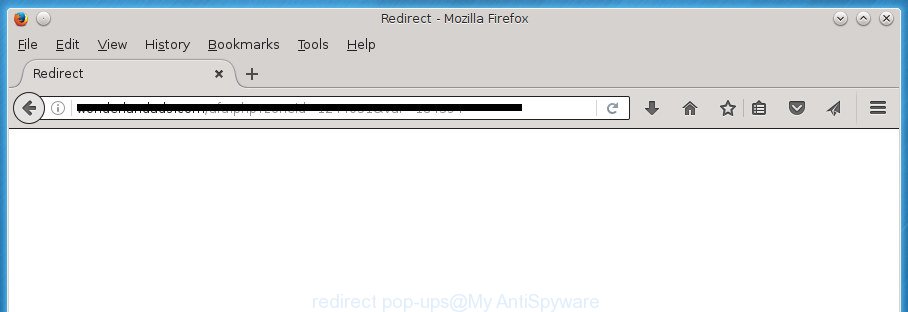
The adware may insert lots of ads directly to the web sites that you visit, creating a sense that the ads has been added by the creators of the web-site. Moreover, a legal advertising links may be replaced on the fake advertisements, that will offer to download and install various unnecessary and harmful software. Moreover, the adware has the ability to collect a ton of personal information about you (your ip address, what is a web page you are viewing now, what you are looking for on the World Wide Web, which links you are clicking), which can later transfer to third parties.
In addition to that, as was mentioned earlier, some adware to also modify all browsers shortcuts which located on your Desktop or Start menu. So, every infected shortcut will try to reroute your browser to undesired ad pages such as this “Redirect”, certain of which might be malicious. It can make the whole computer more vulnerable to hacker attacks.
Table of contents
- What is Redirect
- How to remove Redirect pop-ups
- How to remove Redirect ads without any software
- Deleting the Redirect, check the list of installed applications first
- Fix browser shortcuts, changed by adware
- Remove Redirect pop up advertisements from Google Chrome
- Remove Redirect from Mozilla Firefox by resetting internet browser settings
- Get rid of Redirect pop ups from Internet Explorer
- Delete unwanted Scheduled Tasks
- How to remove Redirect pop-ups with free software
- How to remove Redirect ads without any software
- Run AdBlocker to stop Redirect and stay safe online
- Do not know how your web-browser has been hijacked by Redirect pop up advertisements?
- To sum up
It is important, do not use the “Redirect” web-site and don’t click on advertisements placed on it, as they can lead you to a more malicious or misleading web sites. The best option is to use the few simple steps posted below to free your PC of ad supported software and thereby remove Redirect pop-up ads.
How to remove Redirect pop-ups
Without a doubt, the adware is harmful to your system. So you need to quickly and completely get rid of this ‘ad supported’ software that made to redirect your web-browser to various ad pages. To remove this ‘ad supported’ software, you may use the manual removal tutorial that are given below or free malware removal utility like Zemana Anti-malware, Malwarebytes or AdwCleaner (all are free). We suggest you use automatic removal way that will help you to delete Redirect pop-ups easily and safely. Manual removal is best used only if you are well versed in computer or in the case where adware is not removed automatically. Read it once, after doing so, please print this page as you may need to close your browser or reboot your system.
How to remove Redirect ads without any software
The steps will help you delete Redirect pop-up ads. These removal steps work for the Chrome, Mozilla Firefox, Edge and Internet Explorer, as well as every version of Microsoft Windows operating system.
Deleting the Redirect, check the list of installed applications first
First method for manual ad-supported software removal is to go into the MS Windows “Control Panel”, then “Uninstall a program” console. Take a look at the list of software on your computer and see if there are any suspicious and unknown programs. If you see any, you need to remove them. Of course, before doing so, you can do an Web search to find details on the program. If it is a potentially unwanted program, ad supported software or malware, you will likely find information that says so.
Press Windows button ![]() , then press Search
, then press Search ![]() . Type “Control panel”and press Enter. If you using Windows XP or Windows 7, then press “Start” and select “Control Panel”. It will open the Windows Control Panel as shown below.
. Type “Control panel”and press Enter. If you using Windows XP or Windows 7, then press “Start” and select “Control Panel”. It will open the Windows Control Panel as shown below.

Further, click “Uninstall a program” ![]()
It will show a list of all applications installed on your personal computer. Scroll through the all list, and uninstall any suspicious and unknown software.
Fix browser shortcuts, changed by adware
Once installed, this adware may add an argument like “http://site.address” into the Target property of the desktop shortcut for the Chrome, Internet Explorer, FF and Edge. Due to this, every time you open the internet browser, it will display an undesired ad web-site.
Open the properties of the internet browser shortcut. Right click on the shortcut of infected web-browser and choose the “Properties” option and it’ll show the properties of the shortcut. Next, select the “Shortcut” tab and have a look at the Target field as on the image below.
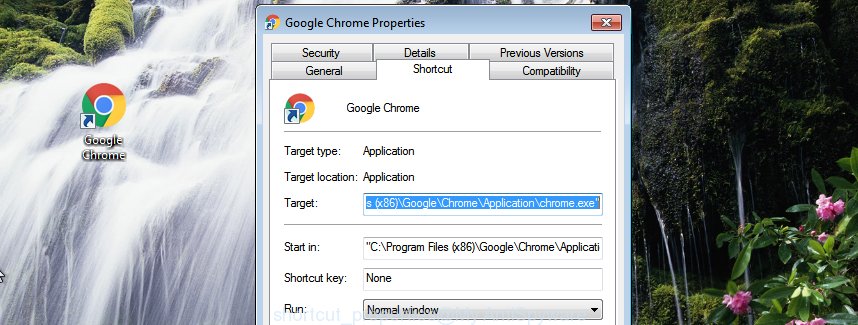
Normally, if the last word in the Target field is chrome.exe, iexplore.exe, firefox.exe. Be sure to pay attention to the extension, should be “exe”! All shortcuts that have been modified by ‘ad supported’ software such as Redirect usually point to .bat, .cmd or .url files instead of .exe as shown in the figure below

Another variant, an address has been added at the end of the line. In this case the Target field looks such as …Application\chrome.exe” http://site.address as shown on the image below.

In order to fix a shortcut, you need to insert right path to the Target field or remove an address (if it has been added at the end). You can use the following information to fix your shortcuts which have been modified by ad supported software.
| Chrome | C:\Program Files (x86)\Google\Chrome\Application\chrome.exe |
| C:\Program Files\Google\Chrome\Application\chrome.exe | |
| FF | C:\Program Files\Mozilla Firefox\firefox.exe |
| Internet Explorer | C:\Program Files (x86)\Internet Explorer\iexplore.exe |
| C:\Program Files\Internet Explorer\iexplore.exe | |
| Opera | C:\Program Files (x86)\Opera\launcher.exe |
| C:\Program Files\Opera\launcher.exe |
Once is finished, press OK to save changes. Repeat the step for all browsers which are rerouted to the Redirect unwanted web site.
Remove Redirect pop up advertisements from Google Chrome
Use the Reset web browser tool of the Google Chrome to reset all its settings like startpage, new tab and search engine by default to original defaults. This is a very useful tool to use, in the case of internet browser redirects to intrusive ad sites such as Redirect.

- First, launch the Chrome and press the Menu icon (icon in the form of three horizontal stripes).
- It will show the Google Chrome main menu, click the “Settings” menu.
- Next, press “Show advanced settings” link, which located at the bottom of the Settings page.
- On the bottom of the “Advanced settings” page, click the “Reset settings” button.
- The Google Chrome will show the reset settings prompt as on the image above.
- Confirm the browser’s reset by clicking on the “Reset” button.
- To learn more, read the blog post How to reset Chrome settings to default.
Remove Redirect from Mozilla Firefox by resetting internet browser settings
If your Firefox web-browser is redirected to various ad web pages without your permission or an unknown search engine displays results for your search, then it may be time to perform the web browser reset.
First, start the Firefox. Next, click the button in the form of three horizontal stripes (![]() ). It will open the drop-down menu. Next, press the Help button (
). It will open the drop-down menu. Next, press the Help button (![]() ).
).

In the Help menu click the “Troubleshooting Information”. In the upper-right corner of the “Troubleshooting Information” page click on “Refresh Firefox” button as shown below.

Confirm your action, press the “Refresh Firefox”.
Get rid of Redirect pop ups from Internet Explorer
The IE reset is great if your web-browser is hijacked or you have unwanted addo-ons or toolbars on your browser, which installed by an malicious software.
First, open the Microsoft Internet Explorer. Next, click the button in the form of gear (![]() ). It will display the Tools drop-down menu, press the “Internet Options” as shown below.
). It will display the Tools drop-down menu, press the “Internet Options” as shown below.

In the “Internet Options” window click on the Advanced tab, then press the Reset button. The Microsoft Internet Explorer will display the “Reset Internet Explorer settings” window as shown on the screen below. Select the “Delete personal settings” check box, then press “Reset” button.

You will now need to restart your machine for the changes to take effect.
Delete unwanted Scheduled Tasks
If the intrusive Redirect web-site opens automatically on Windows startup or at equal time intervals, then you need to check the Task Scheduler Library and remove all the tasks that have been created by adware.
Press Windows and R keys on the keyboard together. This displays a dialog box that called Run. In the text field, type “taskschd.msc” (without the quotes) and press OK. Task Scheduler window opens. In the left-hand side, press “Task Scheduler Library”, as on the image below.
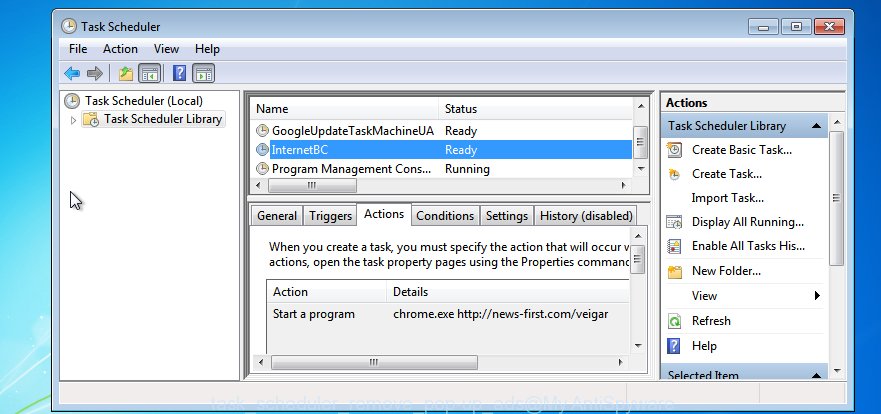
Task scheduler
In the middle part you will see a list of installed tasks. Please select the first task, its properties will be display just below automatically. Next, click the Actions tab. Pay attention to that it launches on your PC system. Found something like “explorer.exe http://site.address” or “chrome.exe http://site.address”, then delete this malicious task. If you are not sure that executes the task, check it through a search engine. If it’s a component of the adware, then this task also should be removed.
Having defined the task that you want to get rid of, then press on it with the right mouse button and choose Delete as shown on the image below.

Delete a task
Repeat this step, if you have found a few tasks that have been created by unwanted applications. Once is done, close the Task Scheduler window.
How to remove Redirect pop-ups with free software
Manual removal steps does not always help to completely remove the ad supported software, as it is not easy to identify and delete components of adware and all malicious files from hard disk. Therefore, it’s recommended that you run malware removal tool to completely remove Redirect off your web-browser. Several free malware removal utilities are currently available that may be used against the ‘ad supported’ software. The optimum method would be to run Zemana Anti-malware, Malwarebytes Free and AdwCleaner.
Get rid of Redirect pop-up advertisements with Zemana Anti-malware
Zemana Anti-malware highly recommended, because it can scan for security threats such adware and adwares which most ‘classic’ antivirus programs fail to pick up on. Moreover, if you have any Redirect popup ads removal problems which cannot be fixed by this utility automatically, then Zemana Anti-malware provides 24X7 online assistance from the highly experienced support staff.
Now you can setup and run Zemana Anti-Malware to remove Redirect pop up advertisements from your internet browser by following the steps below:
Click the link below to download Zemana Anti-Malware installer named Zemana.AntiMalware.Setup on your computer.
164813 downloads
Author: Zemana Ltd
Category: Security tools
Update: July 16, 2019
Launch the setup file after it has been downloaded successfully and then follow the prompts to setup this tool on your PC.

During setup you can change some settings, but we recommend you don’t make any changes to default settings.
When installation is complete, this malware removal utility will automatically launch and update itself. You will see its main window as shown on the image below.

Now click the “Scan” button to begin scanning your PC system for the ‘ad supported’ software that causes multiple unwanted advertisements and popups. A scan can take anywhere from 10 to 30 minutes, depending on the number of files on your personal computer and the speed of your machine. While the tool is scanning, you may see how many objects and files has already scanned.

After that process is finished, you can check all threats detected on your machine. When you are ready, press “Next” button.

The Zemana AntiMalware will delete adware that causes tons of undesired Redirect pop ups. When the process is done, you may be prompted to restart your personal computer to make the change take effect.
How to automatically remove Redirect with Malwarebytes
We recommend using the Malwarebytes Free. You can download and install Malwarebytes to scan for adware and thereby delete Redirect pop up advertisements from your internet browsers. When installed and updated, the free malware remover will automatically check and detect all threats present on the personal computer.
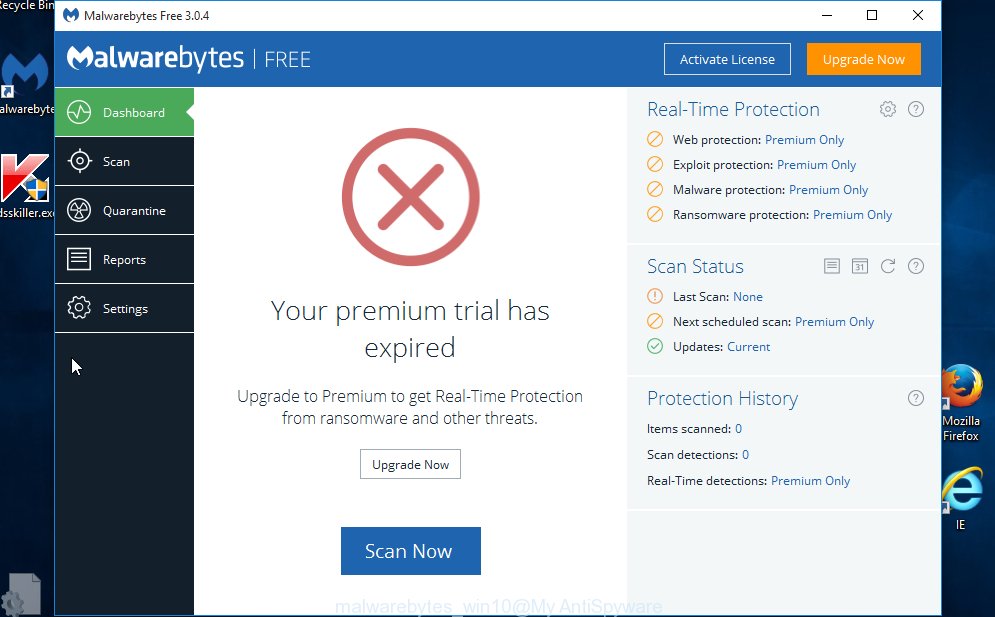
- Download Malwarebytes (MBAM) by clicking on the link below.
Malwarebytes Anti-malware
327070 downloads
Author: Malwarebytes
Category: Security tools
Update: April 15, 2020
- After downloading is finished, close all software and windows on your PC system. Open a file location. Double-click on the icon that’s named mb3-setup.
- Further, click Next button and follow the prompts.
- Once installation is finished, click the “Scan Now” button for checking your PC system for the ‘ad supported’ software that causes tons of undesired Redirect pop up advertisements. A scan can take anywhere from 10 to 30 minutes, depending on the number of files on your personal computer and the speed of your machine. When a threat is found, the count of the security threats will change accordingly.
- When it completes the scan, it will open a list of found threats. Next, you need to click “Quarantine Selected”. Once the clean up is done, you may be prompted to reboot your computer.
The following video offers a steps on how to remove hijacker infections, adware and other malware with Malwarebytes.
Scan and clean your PC system of adware with AdwCleaner
AdwCleaner is a free removal utility that can be downloaded and run to remove adware that cause undesired Redirect pop-ups to appear, browser hijackers, malicious software, potentially unwanted applications, toolbars and other threats from your system. You can run this tool to scan for threats even if you have an antivirus or any other security program.
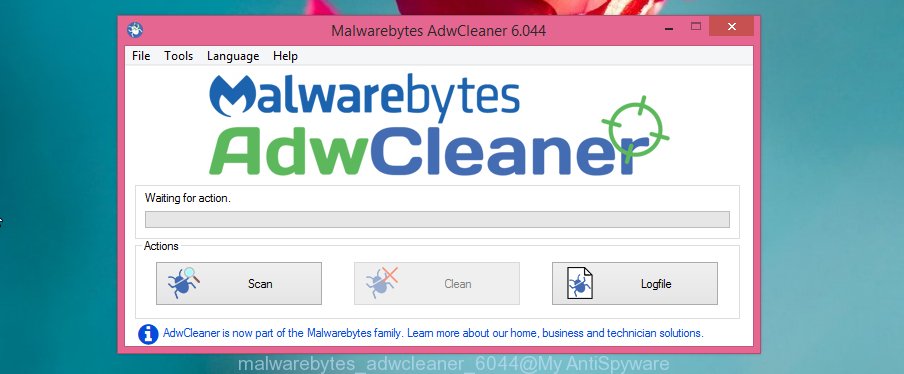
- Download AdwCleaner from the following link.
AdwCleaner download
225545 downloads
Version: 8.4.1
Author: Xplode, MalwareBytes
Category: Security tools
Update: October 5, 2024
- Select the directory in which you saved it as Desktop, and then press Save.
- After the downloading process is done, start the AdwCleaner, double-click the adwcleaner_xxx.exe file.
- If the “User Account Control” prompts, click Yes to continue.
- Read the “Terms of use”, and press Accept.
- In the AdwCleaner window, click the “Scan” to start scanning your personal computer for the ‘ad supported’ software which cause intrusive Redirect pop-up ads to appear. This task can take quite a while, so please be patient. When a malicious software, adware or PUPs are found, the number of the security threats will change accordingly. Wait until the the scanning is complete.
- After the scan get finished, it’ll display a list of detected threats. All detected threats will be marked. You can remove them all by simply click “Clean”. If the AdwCleaner will ask you to restart your machine, click “OK”.
The few simple steps shown in detail in the following video.
Run AdBlocker to stop Redirect and stay safe online
We recommend to install an adblocker application that may stop Redirect and other unwanted web pages. The adblocker utility like AdGuard is a program that basically removes advertising from the World Wide Web and stops access to malicious web pages. Moreover, security experts says that using ad-blocker programs is necessary to stay safe when surfing the World Wide Web.
- Download AdGuard program from the following link.
Adguard download
26842 downloads
Version: 6.4
Author: © Adguard
Category: Security tools
Update: November 15, 2018
- Once downloading is done, launch the downloaded file. You will see the “Setup Wizard” program window. Follow the prompts.
- When the install is finished, click “Skip” to close the installation program and use the default settings, or press “Get Started” to see an quick tutorial which will help you get to know AdGuard better.
- In most cases, the default settings are enough and you do not need to change anything. Each time, when you launch your system, AdGuard will run automatically and block popup advertisements, malicious or misleading sites, as well as other unwanted redirects. For an overview of all the features of the application, or to change its settings you can simply double-click on the icon named AdGuard, that is located on your desktop.
Do not know how your web-browser has been hijacked by Redirect pop ups?
The ‘ad supported’ software usually come as a part of some free software that you download off of the Internet. Once started, it will infect your computer and configure your browsers to open a huge number of unwanted Redirect advertisements without your permission. In order to avoid infection, in the Setup wizard, you should be be proactive and carefully read the ‘Terms of use’, the ‘license agreement’ and other installation screens, as well as to always select the ‘Manual’ or ‘Advanced’ install mode, when installing anything downloaded from the Web.
To sum up
Now your machine should be clean of the adware that causes tons of intrusive Redirect popups. Remove AdwCleaner. We suggest that you keep AdGuard (to help you block unwanted pop up ads and undesired malicious web pages) and Zemana Anti-malware (to periodically scan your machine for new browser hijackers, malicious software and ad-supported software). Probably you are running an older version of Java or Adobe Flash Player. This can be a security risk, so download and install the latest version right now.
If you are still having problems while trying to remove Redirect popups from the FF, Google Chrome, Microsoft Internet Explorer and Microsoft Edge, then ask for help in our Spyware/Malware removal forum.


















